Mark Sisson's Blog, page 377
July 16, 2012
Dear Mark: Too Much Coconut Milk, Donating Blood, De Novo Lipogenesis, and Distilled Water
 The milk of the coconut enjoys an exalted position among in our community. We prize its ketone-generating prowess. We marvel at how it laughs off bile salts with nary a care and goes straight to digestion. Its tendency to shoulder aside longer-chain fats in the acetyl-CoA line doesn’t even come off as a jerk move. And when we find ourselves at southeast Asian eateries, coconut milk-based dishes are always a dependable option. It forms the basis of smoothies, curries, and refreshing summer drinks. Yet one question remains: does such a thing as too much coconut milk exist?
The milk of the coconut enjoys an exalted position among in our community. We prize its ketone-generating prowess. We marvel at how it laughs off bile salts with nary a care and goes straight to digestion. Its tendency to shoulder aside longer-chain fats in the acetyl-CoA line doesn’t even come off as a jerk move. And when we find ourselves at southeast Asian eateries, coconut milk-based dishes are always a dependable option. It forms the basis of smoothies, curries, and refreshing summer drinks. Yet one question remains: does such a thing as too much coconut milk exist?
Find out the answer to that question, plus several more, in this week’s edition of Dear Mark. Let’s get to it:
How much is too much coconut milk? I’m addicted to the stuff.
Matt
When you find yourself skulking around town, glancing furtively up at passers-by as you sip out of a can of coconut milk wrapped in a paper bag, you’ve had too much. If you find yourself holed up in a dingy Albequerque motel room littered with empty tetra-paks of Aroy-D, you’ve got a problem. Other than that, as long as you’re not gaining unwanted body fat, or drinking so much that it displaces other, more nutrient-dense foods in your diet, you’re probably fine.
If you’re curious what I think is the upper limit of sane consumption for other foods like bacon, butter, chocolate, coffee, eggs, nuts and many others, check out How Much is Too Much? and How Much is Too Much? – Round 2.
Dear Mark,
I donate blood regularly and, as you may be aware, post-donation, one is expected to consume sugar in it’s purest form. They provide cookies and fruit juices and all sorts of things which I normally avoid since having gone Primal. So my question is: is there a better, more Primal method, for dealing with suddenly losing a pint of blood, or should I continue eating the sugar?
Thanks!
Susie
From what I understand, the juice is there primarily to get your blood volume back up after a draining, and the snacks are there to get you to sit down, relax, and take a load off for fifteen minutes to recuperate before rushing off and getting into trouble in your potentially-lightheaded state. Since you only have about a teaspoon of sugar in your blood at any one time, a piece of fruit (or even the juice) is plenty to replace anything that you’re missing. As for the fluids, regular water is fine. Coconut water is another good option.
You should probably drink some water beforehand, too, to prepare for the upcoming draining.
Ultimately, there’s nothing magic about the cookies and OJ.
Hi Mark – Great site and book.
I have long been puzzled by the following question: Can excess high blood glucose become fat even if you have glycogen stores available?
Let’s say I have enough muscle to hold 500g of glucose as glycogen and right now only 100g is full. General opinion seems to say whatever excess glucose I take in beyond immediate needs will automatically convert to muscle glycogen until the 500g is full.
However, experience tells me that if you have very high blood glucose some it can be converted to fat *even* if some of it also converts to muscle glycogen, so that eating carbs is not just a simple accounting problem.
Does this seem right to you?
Thanks,
Rob
Studies are fairly consistent that de novo lipogenesis (or conversion into fat) only occurs when glycogen stores are topped off. That is, so long as you’ve got spaces open in your muscles for glucose to be stored as glycogen, postprandial de novo lipogenesis will rarely – if ever – occur to any significant degree. Putting glucose in muscle is one of insulin’s favorite activities; it’s easier to do that than convert it into fat. So, all done, right? That wraps up that?
Ha, if only it were that easy. If only modern humans existed in a state of depleted and then repleted glycogen. If only we weren’t a society of carb-eating, couch-sitting apes with perpetually topped-off glycogen stores. Then, maybe we wouldn’t have to worry about dietary carbs causing so many problems.
We’re not, though. Our sedentary muscles are, by and large, topped off with glycogen around the clock. Oh, sure, we might get so dependent on sugar for energy that walking to our car, clicking the remote control, and reaching for another sip of whatever we’re drinking uses up some muscle glycogen (instead of fat), but most of us are not the insulin-sensitive “healthy young men” with 11-14% body fat, “one of whom is a competitive swimmer” featured in that de novo lipogenesis study (PDF). Most of us can’t handle 500 grams of carbohydrates and many of us are insulin-resistant. And although there are no real studies examining the prevalence of de novo lipogenesis in the insulin-resistant and glycogen-replete, there are hints.
Take this 2011 study, which found that depleting glycogen stores with exercise reduced postprandial de novo lipogenesis in subjects fed a carb-rich meal. Compared to the non-exercising control group, the exercisers experienced three-fold higher postprandial muscle glycogen synthesis (more dietary glucose became muscle glycogen) and a 40% reduction in hepatic triglyceride synthesis (less liver fat produced). It’s clear, then, that studies performed using lean, healthy, and/or glycogen-depleted subjects don’t tell the entire story for everyone else.
As to your situation, you probably don’t have a team of researchers examining the glycogen content of your muscles before and after a meal. You’re just kinda eyeballing things, using the mirror and your subective impression of how things are going or not going – like all of us. So I don’t have a hard answer for you, unfortunately. I don’t know exactly what your capacity for de novo lipogenesis looks like, because that depends on the degree of glycogen depletion, the carb load, your insulin sensitivity, and plenty of other variables. What I can tell you is that any available space in your muscles for glycogen will be filled by incoming dietary carbohydrate before de novo lipogenesis occurs.
The question becomes: are you truly glycogen depleted? Most people aren’t.
Mark,
I read your blog alot and hand out in the forums occasionally. A topic that has come up for me lately is whether distilled water is good for you to drink. My father in law (chiropractor) swears by it, but a guy I know at work (biology Major) is adamantly against it.
Do you have any thoughts on it or any legitimate articles you could point me to that are not supported by distillers or bottled water companies.
Cheers. Thanks.
Brad
I don’t really have a dog in this fight, and I’m unaware of any studies dealing directly with the safety or danger of drinking distilled water, but there is evidence that drinking mineral water (whether it’s high mineral tap water, well water, or bottled mineral water) confers significant health benefits. Let’s take a look at some evidence of minerals in drinking water affecting health, shall we?
Magnesium content of water is associated with lower mortality from heart attacks.
Serbian municipalities with high-magnesium drinking water have less hypertension than areas with low-magnesium water.
Magnesium content of tap water seems to be inversely correlated with cardiovascular disease mortality.
Calcium content in drinking water is associated with a reduced risk of kidney cancer.
Geographic regions with higher lithium content in drinking water have lower suicide rates.
And in a really odd one, drinking high-mineral deep sea water lowered lipid peroxidation, total, and LDL cholesterol in subjects with high cholesterol.
Of course, most of these studies are epidemiological, and thus inconclusive, but they point to a possible effect. My thinking? It’s not that distilled water is bad for you. It’s that minerals are good for you, and drinking water was a common, ancestral source of minerals for most of human history. Much like the modern obsession with sterility (hand sanitizers on keychains, etc.) has robbed us of important exposure to dirt and microbes, perhaps our obsession with “purified” water has robbed us of vital minerals.
I still drink tap water, but I also keep a bottle of trace mineral drops on hand. A couple drops in a glass of water, a half teaspoon in a jug, and you’ve effectively remineralized your water (and anything you use that water to cook). For example, if you’re going to be cooking up some white rice (for whatever reason), a teaspoon of minerals in the cooking water will make the nutrient-poor grain nominally more nutrient-dense.
That’s it for today. Questions, comments, concerns? Leave them in the comment section. Thanks for reading!
Grab a Copy of The Primal Blueprint: Updated and Expanded Paperback Edition and Start Getting Primal Today!

July 15, 2012
Weekend Link Love
 Because ninjas never sat down to type WordPress blogs.
Because ninjas never sat down to type WordPress blogs.
Speaking of ninjas, let Al Kavadlo show you how to do a kip up.
Should we kill animals that kill humans?
A recent study suggests that “dense acellular carbohydrates” (in other words, grains) were found to promote inflammatory intestinal microbiota, as opposed to carbohydrates from “cellular tubers, leaves, and fruits.” Sound familiar to anyone else?
The Human Food Project quizzed a group of 37 microbiologists about their thoughts on diet and gut flora, including what a diet that promotes a healthy microbiome would look like. The results are pleasantly unsurprising.
New research shows that traditionally-shod runners who go barefoot for the first time immediately improve their running economy and adopt a shorter stride length.
All the more reason to support pastured (or at least organic) poultry: antibiotic use in chickens has been linked to bladder infections in humans.
Did you know that the Paleo diet is uncivilized, unhealthy, and untrue? That we’re just all a bunch of savage bloodthirsty heathens? Yeah, apparently it’s true. Seriously, though: a $50 gift certificate to PrimalBlueprint.com to the person who comes up with the best comeback or rebuttal in today’s comment section. The Worker Bees and I will judge. Contest ends at midnight PDT, July 17 – two days from now.
Co-evolution, schmo-evolution; pit bulls are natural born killers. Right?
Recipe Corner
Because I know that rabbit has been burning a hole in your chest freezer.
For a quick, non-caloric change of pace, here are 10 recipes for health-boosting herbal tea, courtesy of the Wellness Mama.
Time Capsule
One year ago (July 15 – July 21)
Eating Earth: Exploring the Mysterious World of Geophagy – Eat earth, mostly topsoil?
8 Natural Ways to Prevent a Sunburn (and Sunscreen’s Not One of Them) – Prepare your skin before you head out to make vitamin D.
Comment of the Week
Oh boy, you’re putting your foot in it again, Mark! ;o) *says the grandma who is younger than you and who is also interested in the science of it*
- Yup, I shoulda known, Janet and Estelle. My apologies to all the grandmas out there.
Grab The Primal Blueprint Cookbook Today and Receive Free S&H and a Free Primal Blueprint Poster

July 14, 2012
Raspberry Butter Sauce with Crispy Salmon and Salad Greens
 Admittedly, Raspberry Butter Sauce walks a fine line between a sauce and a salad dressing. Drizzled over crispy, pan-seared salmon on a bed of greens, it is both of these things at once. The flavor is fruity and slightly sweet, balanced by a tangy zip of acidity from red wine vinegar and a pinch of sea salt. Add a few fresh raspberries to the salad and you have a perfect summer meal.
Admittedly, Raspberry Butter Sauce walks a fine line between a sauce and a salad dressing. Drizzled over crispy, pan-seared salmon on a bed of greens, it is both of these things at once. The flavor is fruity and slightly sweet, balanced by a tangy zip of acidity from red wine vinegar and a pinch of sea salt. Add a few fresh raspberries to the salad and you have a perfect summer meal.
Compared with other types of fruit, raspberries are lower in sugar and they’re also loaded with fiber, vitamin C, manganese and antioxidants. Raspberries add a burst of sweet acidity to salads and are especially good with salmon and pork. In fact, this salad topped with Raspberry Butter Sauce would be equally delicious with slices of crispy grilled pork.
Straining the sauce through a fine mesh sieve is optional, but recommended if you want a silkier, lighter texture and a flavor that’s more tangy than sweet. You’ll only end up with a tablespoon or two of sauce/dressing, which is fine, because a little bit of the flavor goes a long way. This isn’t a sauce to drown a meal in. It’s one to drizzle lightly to bring a little taste of summer to your plate.
Servings: 2
Ingredients:
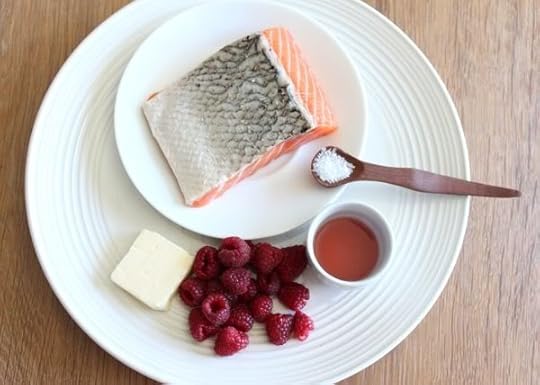
2 salmon filets, skin on
1 tablespoon oil (for searing salmon)
20 fresh raspberries (or fewer, for a flavor that is less sweet)
2 tablespoons unsalted butter, melted
1 1/2 teaspoons red wine vinegar
Pinch of sea salt (about 1/8 teaspoon)
Instructions:
Lightly salt both sides of the salmon.
Heat oil in a frying pan/cast iron skillet over medium-high heat until the oil is good and hot and starts to crackle a little. Place the salmon in the pan, skin side down, and cook until it is nicely browned and more importantly, no longer sticks to the pan, about 3 minutes. If you turn the fish too soon, it will stick and the skin will rip off, so be patient.

Flip the fish over and cook on the other side, about 3-5 minutes more for a filet that is 1 – 1 1/2 inches thick. If the middle is still not cooked enough for you after this amount of time, lower the heat a little and cover the salmon with a lid for a few minutes more.
To make the Raspberry Butter Sauce, blend the raspberries and melted butter in a blender until smooth.
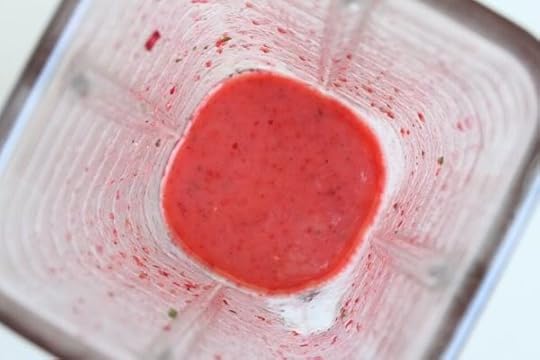
Scrape into a bowl and mix in vinegar and sea salt. Optional: Strain the sauce through a fine mesh sieve set over a bowl, pressing down on the solids to push out the liquid. You’ll only end up with about 2 tablespoons of sauce/dressing.
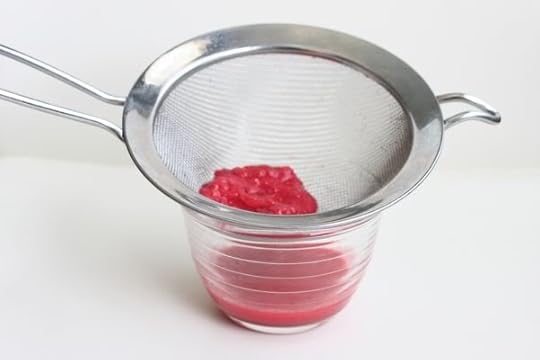
Toss with greens and/or drizzle over the salmon.

Get the Primal Blueprint Fitness eBook, Free Health Tips and Primal Recipes Delivered to Your Inbox

July 13, 2012
From Cancer Back to Health
It’s Friday, everyone! And that means another Primal Blueprint Real Life Story from a Mark’s Daily Apple reader. If you have your own success story and would like to share it with me and the Mark’s Daily Apple community please contact me here. I’ll continue to publish these each Friday as long as they keep coming in. Thank you for reading!
 Hi Mark,
Hi Mark,
I’ve been holding off on writing up any “success story” about myself even though I have met and even surpassed my weight loss goals with Primal eating and the Primal Blueprint Fitness plan.
That is because this journey, for me, has been much more about regaining and maintaining my health for life. Looking good in a swimsuit is just a side benefit.
Five years ago, at the age of 45, I was diagnosed with breast cancer, a fast growing invasive bugger that surely would have killed me without medical intervention. Over the course of two and a half years, I had eight surgeries and six rounds of chemo. That is a lot of time with a lot of enforced inactivity and the pounds just piled up. Chemo also does a number on your thyroid function which didn’t help any.
And then there is the psychological aspect of being seriously ill. The feeling of, screw it, I’m going to finish the pizza if I feel like it. I have cancer. A few extra pounds are the least of my problems.
As it turns out, those extra pounds were a major problem. When I asked my oncologist what I should be doing to help prevent a recurrence, his first words were a no-nonsense, “You need to lose weight. Extra fat cells are a source of estrogen which can trigger cancers such as this.”
That was the kick in the pants that I needed to start doing something about the problem. But where to start?
I had always been an active, healthy kid and young adult, into surfing, backpacking, hiking, swimming and even taken a detour into bodybuilding in my 20′s. My diet had always been the health food version of CW, lots of veggie and tofu stir-fries with brown rice, never the SAD at all.
A few pounds had crept up on me as I passed 40, but during my illness I ballooned up to a size 16 and 210 lbs. I am 5’10″ but that is still too big.


Note my chin’s evil twin and the tank top strap disappearing into squishy stuff.
I tried white knuckle calorie restriction and got nowhere. A friend had some good results with Atkins so I started looking into lower carb eating and came across several interesting articles about ketosis as an adjunct to cancer treatment.
In addition to battling cancer, I have also had a seizure disorder since college. I had also been doing some research into the ketogenic diets that have worked so well for many with epilepsy.
At Johns Hopkins they are using something they call the “Modified Atkins Diet” or MAD in the treatment of epilepsy with excellent results. This spurred me to look further into Atkins, but I was dismayed by all the fake ingredients in the bars and shakes you supposedly need to do their program.
So, both my cancer research and my epilepsy research were pointing me in the same general direction as I went looking for an all natural alternative to Atkins.
On the way to Primal I stopped off for a while with the book called “Diet Evolution” by Dr. Stephen Gundry. Its induction phase is basically the same as Primal and it worked beautifully. I lost 30 pounds like falling off a log. Gundry explains about neolithic/paleolithic dietary changes and that made a lot of sense to me. But then Gundry goes on to “evolve” the diet further back in time so that you are basically eating like a gorilla, only veggies with a protein garnish and then he re-introduces grains. At that point it stopped working, surprise, surprise. That’s where he lost me and I went looking again.
So this was my long and winding path to Primal. I thought I had found the holy grail. I lost five pounds in the first week, in hindsight probably water weight due to ditching the dairy and soy.
I was already grain and sugar free and had always been a big fan of lots of veggies and salads all my life. Primal just gave me “permission” to embrace all that evil animal protein and fat. And I did, with a passion and with excessive portions.
This is where I would like to say to all newbies around here: READ THE BOOK FIRST before you listen to forum advice. In The Primal Blueprint there is an entire chapter on portion control and calorie targeting. Much of the forum “wisdom” however said to chuck your scale out the window and just eat your bacon and be happy and the pounds would fall off magically.
Guess what. Didn’t happen. I gained back those first five plus five more and then read the book and realized I needed to cut portion sizes and get my calories under control. I think Taubes got part of the story right. There are good calories and bad calories, but even with just good ones, too much is still too much.
I dialed back on all that yummy fat and increased my lean protein intake while cutting overall quantities of food. The scale started moving again and kept going down for another 35 pounds to 145, five pounds under my goal of 150 and a size 6 when my goal had been an 8.

Since then I have put on a few pounds by taking a cruise, and taken them off again the same way, Primal with sensible portion control. All in all I have been maintaining here quite easily.
Every time the subject of calories comes up on the forum, people seem to square off into two extreme camps. One side is the “It doesn’t matter what you eat, only how much you eat” strict CICO approach. In the other corner there are is “CICO is bogus, you can eat as much as you want as long as you eat the right things.”
And then there is me saying wait a minute. Why does it have to be either the quantity OR the quality of the calories. I think it’s BOTH. Eating the right kind of foods (Primal) makes it easier to restrict the quantity of food without feeling like you are going to faint from hunger.
The people who say that you can just “eat when you are hungry, stop when you are not” don’t get what it’s like to have a completely messed up metabolism. When you can’t just “listen to your body” because it’s telling you lies about how much to eat, you need to impose some control on the situation from the brain down.
Now that I am at a healthy weight with a well functioning thyroid, I can listen to my body and trust what it’s saying. It’s wonderful.
Last year I climbed Mt. Kilimanjaro and it was pretty easy. My knees don’t hurt anymore. I don’t get puffy ankles like I used to when I was heavy.

Then a couple of weeks ago something wonderful happened for me. I had my five years post cancer check up including mammogram, bone density scan, and blood work.
The mammogram was clean and the post chemo osteopenia I had is gone. My thyroid is healthy again and I have healthy levels on all the vitamins and such.
This all-clear was the news I was waiting on before calling myself a success.
I want to shout out to all the people out there who have suffered an accident or illness that has put them way deep in the hole of despair mentally as physical health spirals out of control. I know how you feel. But, please don’t give up on yourself. Yes it is hard to battle back from the bottom of that hole, but it is SO worth it.
I am so glad to be to be healthy again.
Sure, there is scar tissue. I don’t care. I’m alive.
These undies (NSFW – scroll to last post in thread) were something I bought for a cancer fundraising campaign when my size 16 behind would never have fit into them. Now cancer can kiss my size 6 behind.
Grab The Primal Blueprint Cookbook Today and Receive Free S&H and a Free Primal Blueprint Poster

July 12, 2012
Autism: A Brain or Whole-Body Disorder?
 You could say this post is a long time coming. In the last few years, I’ve lost count of the huge number of emails I get from parents with kids who have special needs either asking for advice or explaining how The Primal Blueprint has made a significant difference for their children. These are parents who love their kids for all their abilities and differences and who want to explore every reasonable lifestyle intervention they can to make their kids’ lives everything they can and should be.
You could say this post is a long time coming. In the last few years, I’ve lost count of the huge number of emails I get from parents with kids who have special needs either asking for advice or explaining how The Primal Blueprint has made a significant difference for their children. These are parents who love their kids for all their abilities and differences and who want to explore every reasonable lifestyle intervention they can to make their kids’ lives everything they can and should be.
I’ll state the obvious here. I’m not a disability expert, but I’ve been moved and motivated by these parents’ emails. From a general health perspective, I’ve wondered how our modern lives could be contributing to the epidemic. Likewise, I’m curious how research can illuminate potential benefits of lifestyle interventions. What is the biological picture behind the dysfunction in these conditions, and how can biology be harnessed to restore functioning? A recent approach focused on the whole brain and whole body is asking those exact questions – and finding answers.
Like most people, I have friends and acquaintances who are raising children with developmental or behavioral disabilities. Some of us here are raising children with these conditions. Some of us have nieces or nephews, family friends, or neighbors with these disabilities. Others in the PB community have these disabilities themselves. Regardless of our personal connection, we’ve all heard about the skyrocketing rates of developmental and behavioral disabilities like autism and ADHD. Recent studies show one in six kids in the U.S. has been diagnosed with a developmental disability – mostly resulting from the spike in autism and ADHD. There’s general agreement now it’s not solely a matter of improved diagnosis, and few anymore argue that it’s purely a genetic phenomenon. Simple math negates the possibility that a “genetic” condition would spike in the span of less than half a generation. Since 1995, autism alone has gone from a rate of 1/3300 children to 1/88 children. Prevailing opinion now connects the rising prevalence of these conditions with a confluence of some kind of genetic vulnerability with pivotal environmental factors that somehow set off this genetic potential.
Enter the growing focus on not just “whole brain” but even “whole body” research and intervention for these kinds of disabilities. Our bodies are incredibly complex systems operating with an intricacy conventional medicine is just beginning to grasp. Experts are increasingly applying these principle to the study of autism, ADHD, and other developmental and behavioral disabilities. They’re looking at elements as diverse as gut profiles, neurological connectivity, and gene expression. A picture is emerging as researchers study the surge of these conditions. The “genetic” root is relatively seldom the traditional, identifiable pattern in family lines. Rather, it appears many of these children have inherited a genetic risk factor characterized by a heightened sensitivity to “assaults” on the system from toxins, infections, and other environmental influences. As Nancy Minshew, a University of Pittsburgh professor of psychiatry and neurology explains, “Genes do not code for diagnoses. They code for proteins, which then go about creating an effect.” In other words, a cycle is set in motion. Is it possible to stop the cascade that unfolds and even reverse it – at least in part?
A New Focus for Autism Research
Dr. Martha Herbert, a Harvard pediatric neurologist who has studied autism for seventeen years, believes it can be done. She began research into autism with the same genetics-focused approach common to the field. In her words, she quickly found the picture to be much more complex. In her recently published book The Autism Revolution: Whole-Body Strategies for Making Life All It Can Be, Dr. Herbert explains how addressing basic coexisting medical issues and optimizing overall health can positively and sometimes dramatically impact the symptoms associated with autism. I’d definitely recommend Dr. Herbert’s book to anyone interested in learning more about a biological treatment approach to autism.
Initially interested in comparing MRIs of her patients, Dr. Herbert began to see an interaction of neurological functioning with other physical issues like poor digestion, low muscle tone, fatigue, frequent infections, nutritional deficiencies, and food allergies. She found that “treating health” ended up treating autism. Herbert describes the series of “vicious cycles” that often plague those with autism as one of “genetic glitches, oxidative stress, mitochondrial dysfunction, and weakened repair systems.” Biologically based treatment, she asserts, can support basic cellular health, aid neurological balance and connectivity, and promote healthier gene expression. It’s a systems biology approach that appreciates the interactions – both big and subtle.
In the meantime, experts were finding – and confirming – that seemingly unrelated factors like fevers or the use of certain steroids or blood pressure medications could almost instantaneously dial back autistic symptoms. These instances – as well as the basic progress of many individuals on the spectrum – suggested autism was perhaps more of a flexible “state” than a fixed “trait.” If this was possible, what could be done safely and systemically to take advantage of this potential fluidity?
Dr. Herbert outlines a whole host of lifestyle based suggestions surrounding diet, toxin free living, supplementation, sleep, sensory exposure, stress, and other daily factors. There’s too much to explain here, but let me summarize a few of her central points and put it in context for those who live Primally.
Nutrition Is Key
However it shakes out in the chicken versus the egg picture, individuals on the autism spectrum are prime targets for nutritional deficiencies, yet they’re more in need of nutrients than their typically functioning counterparts. As Dr. Herbert and others have found, individuals on the spectrum show signs of oxidative stress and impaired cellular dysfunction. Dr. Herbert explains, for example, that mitochondria dysfunction is much more common in those with autism than it is in the population as a whole. Research suggests a third of those with autism have mitochondrial dysfunction. As I’ve noted before and as Herbert explains, mitochondria are the energy centers or “furnaces” for cells. If your mitochondria are choking through their day, so are you. Fueling these furnaces means feeding them well. B-vitamins are critical as are minerals like magnesium and zinc. Not surprisingly, these are common deficiencies in many people on the autism spectrum.
Likewise, research shows basic toxin and cellular waste removal may not be as efficient in individuals with autism. Antioxidants are essential here, particularly the heavy hitters like vitamins C and E as well that powerhouse glutathione. Nutritional deficiencies mean the building blocks for glutathione (which the body produces itself) are in short supply. When glutathione levels are inadequate, a whole host of vital processes feel the impact. For one, the body can’t effectively dispose of cellular waste, a condition that then further feeds oxidative stress. Among other impaired activities is methylation, which is involved in producing neurotransmitters, managing gene expression, and creating functional cell membranes.
Dr. Herbert advises getting a full nutritional panel, eating a nutrient rich and clean (e.g. organic, grass-fed, “caveman” – yes, she really says this) diet, supplementing with oversight from a qualified physician with experience in autism disorders, and using Epsom salt baths to help the body detoxify in a safe and convenient way. Her dietary and supplementation recommendations are too complex to fully describe here, but some key nutrients she notes include B-vitamins, zinc, vitamin D, selenium, EPA, and DHA. The irony is, of course, that these children’s diets are often more likely to be deficient because of sometimes extreme sensory aversions to the taste, smell, texture, or even appearance of certain foods. In yet another example of vicious cycle, nutritional deficiencies (e.g. zinc) can contribute to these sensory aversions. She suggests correcting deficiencies and taking advantage of feeding clinics and sensory therapies to expand food tolerance.
Neurologically speaking, the connections between parts of the brain in people with autism, she found, are weaker than they are in typically functioning individuals. Other research suggests people with autism show hyperlocal connections, a concentration of connections within the brain – generally in the frontal cortex, and weaker “distant” connections throughout the whole brain. It began to make sense, Dr. Herbert suggests, that people with autism often exhibit lower functioning in complex, neurologically integrated tasks like language and socialization as well as a heightened sensitivity to sensory stimuli.
Options like music and certain play therapies cultivate connectivity because they use multiple sites in the brain simultaneously, but Dr. Herbert also stresses the importance of nutrition for neural health. She homes in on the role of astrocytes (glial cells), which act as the “interface between body, brain, and environment.” If they’re unable to perform their duties, here comes the cascade of neurochemical imbalance (including a dearth of relaxation-promoting GABA), oxidative stress, drained mitochondrial health, and cellular dysfunction. Again, it’s another downward spiral. Feeding the glial cells means incorporating copious essential fatty acids, especially EPA and DHA, as well as B vitamins, and magnesium. In the cases of those with autism, upper limits on nutrients like B6 may not apply the same way. Nonetheless, Dr. Herbert suggests working with a doctor who can find a therapeutic dose that doesn’t impose unwanted and risky side effects.
Immune Function (Especially Gut Health) Is Key
Remember those glial cells? Most of your glial cells are found in the digestive system rather than the brain. As Dr. Herbert explains, research is just beginning to understand the implications of this for autism disorders. Overall, she explains that gut bacteria has a huge impact on the brain. Abnormal gut bacteria can deplete nutrients and produce unhealthy chemicals Herbert calls “toxic trash.” Research has found, for example that the more p-cresol (a chemical produced by abnormal gut bugs) that was present in subjects’ urine, the more severe their autistic symptoms were.
Dr. Herbert stresses that we don’t know when the abnormal gut profile takes root, but everyone’s gut immune system is established early on. She suggests incorporating fermented and cultured foods, using a probiotic supplement, avoiding over-sanitation, eliminating artificial additives, and limiting carb intake. While some experts poo-poo diet elimination techniques, Dr. Herbert says she’s seen more than enough evidence in research and in her patients to suggest that these elimination diets (e.g. gluten, casein) can make a critical difference. The key is to give it time – some three to six months – to judge real change and to work with a physician who can differentiate between “die off” (e.g. yeast) transitions and other health responses when looking at any coinciding setbacks.
Some Final Primal Words
Our lives – and our children’s lives – are so vastly different today than they were just a couple of generations ago. These differences are embedding themselves faster than we sometimes appreciate. I wonder if it’s just simple coincidence that many new treatments for autism spectrum, ADHD, and other developmental and behavioral disabilities are homing in on maximizing what I’d call the basics of healthy development itself – enhanced nutrient density, increased time outdoors, more exercise and movement, rich play opportunities. To be sure, many of these are often adapted for particular therapeutic purposes like specialized social play therapies, music therapy, or Anat Baniel’s movement methods. Nonetheless, these approaches prioritize the building blocks of physical, cognitive, and socio-emotional development.
It’s true there are plenty of children with autism or ADHD who grew up eating real, organic, even Primal food, who played outside nonstop, and lived with fewer household toxins. Likewise, there are millions of kids walking around without a disability who have been fed a steady diet of fast food, candy, and junk food. As Herbert and others suggest, it’s a complicated, confounding picture we’re dealing with. It can seem random and unjust.
I can’t say I know this from personal experience with special needs in particular, but I’ve seen friends wade their way through the tangle of emotion and services as well as the confusion of expert opinions. (It’s a pattern that also obviously holds in other “expert” based arenas as well like health care.) Just because the bulk of research goes down a certain path doesn’t mean you have to. Often the best, most sensical and personally effective means for bettering one’s health and life are to be found in the margins, the up and coming or as-yet little understood approaches.
Make no mistake. I’m all for the importance of good research. I look for confirmation. I know, however, that effective options don’t always get studied or published with the same frequency as conventional choices. As the folks at Brain Parenting put it, “the ‘good science’ metric is often wielded like a stick against parents or teachers who try new and novel techniques to help kids with unusual brains. Parenting doesn’t just rely on ‘good science.’ It also relies on observation, and derives great power from the narrative.”
The research on whole brain, whole body intervention doesn’t negate the importance of traditional interventions like speech and occupational therapy, social therapies, etc. It doesn’t nullify the call for medications that can actually make a positive difference in the lives of those with autism, ADHD, or other similar conditions. It doesn’t undercut the significance of parental love and acceptance. And, inevitably, it doesn’t offer a simple or universal resolution to the difficulties imposed by autism or other developmental and behavioral disabilities. As Dr. Herbert explains, it’s not about promising a cure but revolutionizing the way we think about and address these developmental and behavioral conditions. The whole brain, whole body approach seeks to harness the basics of biology – cultivating the power of cells, the fitness of whole systems, and the potential of brain plasticity – to foster the healthiest and richest life possible for every individual whether he/she is disabled or not.
Thanks for reading today, everybody. I hope you’ll offer your own thoughts and perspectives. I’ll look forward to reading your feedback.
Get the Primal Blueprint Fitness eBook, Free Health Tips and Primal Recipes Delivered to Your Inbox

July 11, 2012
12 Health and Fitness Blogs You Should Be Reading
 With the Primal/paleo/ancestral/real food/whatever-moniker-you-prefer community growing by leaps and bounds over the past year, I thought I’d do another “blogs you should be reading” post. I’ve done this sort of thing before, both last year and the year before. Once again, there are a ton of blogs out there that I’ve either missed or forgotten to include in previous installments, along with newer ones that are newer and therefore less likely to be on my (or anyone’s radar). But that’s how we rectify the situation and get even more people reading these great blogs – by calling attention to them. Now, not all of them are strictly Primal; some only give passing mention to the specifics of evolutionary health. All the blogs included, however, are relevant to anyone interested in learning about health, fitness, nutrition, and general wellness. And isn’t that what we’re all doing here, anyway? Trying to learn how to improve our lives and the lives of those around us?
With the Primal/paleo/ancestral/real food/whatever-moniker-you-prefer community growing by leaps and bounds over the past year, I thought I’d do another “blogs you should be reading” post. I’ve done this sort of thing before, both last year and the year before. Once again, there are a ton of blogs out there that I’ve either missed or forgotten to include in previous installments, along with newer ones that are newer and therefore less likely to be on my (or anyone’s radar). But that’s how we rectify the situation and get even more people reading these great blogs – by calling attention to them. Now, not all of them are strictly Primal; some only give passing mention to the specifics of evolutionary health. All the blogs included, however, are relevant to anyone interested in learning about health, fitness, nutrition, and general wellness. And isn’t that what we’re all doing here, anyway? Trying to learn how to improve our lives and the lives of those around us?
Let’s get to the blogs. In no particular order:
Melissa and Dallas Hartwig form the core of the Whole 9 team. Their philosophy revolves around the Whole 30, a 30-day trial run of complete and utter purity and adherence to the diet, and word has it that it’s brutally effective. They also just came out with a book, to which I gave some recent link love, but most importantly, they’re absurdly good looking, write a great blog wherein they give excellent training/eating/living advice, and coin such awesome phrases as “sex with your pants on.” Let them “change your life.”
Stefani Ruper is the gal who spurred that women and fasting post from a couple weeks back. If you dug her perspective on the topic of intermittent fasting, you’ll really love her blog, which deals with, well, it’s right there in the name – Paleo for Women. The hormonal situation in women is a totally different ball of wax than the admittedly simpler and more straightforward endocrine system in men. We deal in the same raw materials, sure, but the amounts, proportions, and effects are different. To get a handle on all this stuff, check out her blog (where she also deals with another oft-ignored topic in our community, eating disorders).
70s Big has evolved over the years. What began as an online homage to heavy squats, big deadlifts, bigger meals, even bigger mustaches, short shorts, tank tops, and the hirsute men of the greatest decade ever to grace the 20th century has become a training blog that promotes smart training, smart programming, and smart eating, breaks down complex kinesiological and anatomical concepts, and yes, still pays homage to heavy squats, big deadlifts, bigger meals, even bigger mustaches, short shorts, tank tops, and the hirsute men of the 70s who bore them. If you’re into lifting, check it out.
I’ve mentioned Kelly Starrett before. Heck, I even invited him to the last PrimalCon, where he loosened wound-up hip capsules, blessed attendees with improved thoracic mobility, and mashed quads galore. But I’m going to do it again, in a formal way, because you probably need what he’s giving. If you’re a human being with (technically) working limbs, you should visit Mobility WOD, try a few of the WODs, test-retest, and note the improvement in your movement. Oh, and whatever you do, stay out of the pain cave.
Though perhaps not the first choice you’d send to your grandma interested in all this “nutrition stuff you’re always yammering on about” to read, the blog of molecular biology expert Lucas Tafur is worth studying. He’s keenly interested in the interplay between our nutrition, the gut microbiota, the immune system, inflammation, and our health. His tagline says it all: “We are 90% microbes and 10% human.” If you’ve ever wondered about those things, and you have a scientific bent, get on over to Lucas Tafur’s blog.
To nom is to “eat something.” To nom nom is to “eat something vigorously and with great enthusiasm.” To nom nom Paleo is to “eat fantastic Paleo chow.” That about sums up Nom Nom Paleo, a Palo Alto, CA-based blog wherein the purveyor takes stunning photographs of food and family, provides great recipes (Kalua pig is probably my favorite so far), and along the way ends up giving excellent advice to families trying to make this Primal thing work in a decidedly non-Primal world.
A former MovNat master trainer, Clifton has moved ship to San Diego, where he dispenses training advice, helps men and women develop rotunder posteriors, and has singlehandedly jumpstarted a seriously-suffering V-neck industry. He offers online consulting, as well as poignant insight on topics pertaining to getting stronger, fitter, faster, and more mobile.
Denise Minger, infamous study-eviscerator and bane of vegans everywhere, eats a near-vegetarian raw food diet. Huh? Yeah, it’s crazy. She’s not about Primal, or veganism, or carnivorism, or anything with a label. She’s only interested in disseminating the truth about nutrition. Which is why you should read her blog, especially if you’ve already enjoyed her many guests posts on this site. Oh, yeah, she’s also pretty darn hilarious.
What’s not to love about a blog meticulously written and researched by a ketotic, self-experimenting, endurance athlete MD? Inside The Eating Academy you’ll find well-researched posts on a variety of topics, including an epic series on blood lipids, posts about training in ketosis, and the dangers (or not) of non-nutritive sweeteners. The blog began as The War on Insulin, but Peter Attia has expanded his focus to encompass a wider range of topics. At about a year old, it’s one of the newer blogs around, but it’s already getting loads of attention and providing great content, and I’m excited to see what he has in store for us.
Suzanne Crawt, also known as Paleo Suz, is a frequent attendee of PrimalCon, coming all the way from Australia. And she’s put together a great resource for Australians and New Zealanders interested in making Primal work in their neck of the woods. If you want to know where to get the best prices on compliant products, how to cook Primal versions of traditional local foods, find Australian and NZ health professionals with an ancestral bent, or connect with other folks of similar mindsets who live there, the Paleo Network is the spot to do it.
I’m halfway convinced that Suppversity is written by a robot. The highly detailed, data-and-insight-packed breakdowns of studies he churns out on a near-daily basis boggle the mind and seem unreal. But they’re real, and they’re informative. If you’re interested in hearing about the latest study on the estrogenic effects of soy protein, the asthma-fighting effects of whole milk, or whether that workout supplement you keep hearing about actually works, read Suppversity.
Although we do our best to make Primal living in this non-Primal world work, it’s not always easy. And sometimes, you want to hear from someone who’s faced this conundrum and (seemingly) won, particularly if they have a smart, clean writing style. You could probably learn a thing or two from a person like that, right? Luckily, Paleo/NonPaleo is a blog almost entirely devoted to that exact dilemma, with that exact writing style. Start with her inaugural post that drew the fans in – 27 Ways to Live With Your Non-Paleo Spouse – and see what you think. Then, explore the rest of the site.
As always, I’d love to hear from you. What are your favorite Primal-friendly blogs? Do you read the ones I’ve listed? Why, or why not? Are there any you’d remove from the list? Let me, and everyone, know in the comment section! Thanks for reading, folks.
Get the Primal Blueprint Fitness eBook, Free Health Tips and Primal Recipes Delivered to Your Inbox

July 10, 2012
What Does It Mean to Be Fat-Adapted? – Part 2: Q&A
 As I figured it would, last week’s post on fat-adaptation generated a lot of comments and questions. I couldn’t answer all of them (maybe another time), so for today’s post, I tried to collate the most burning questions to arrive at a representative sample. That way I hit the major ones without making this one of those super long posts. If you feel I’ve missed any major ones, feel free to let me know in the comment section.
As I figured it would, last week’s post on fat-adaptation generated a lot of comments and questions. I couldn’t answer all of them (maybe another time), so for today’s post, I tried to collate the most burning questions to arrive at a representative sample. That way I hit the major ones without making this one of those super long posts. If you feel I’ve missed any major ones, feel free to let me know in the comment section.
First up is the most basic of questions: how does one become fat-adapted? Some, probably most, of you have a good idea how to go about doing such a thing, but not everyone. And so, without further ado, let’s get to the questions:
How do I become fat-adapted?
Ramp up your fat intake. This will spur your body to increase fat-digesting enzymes that have likely laid rather dormant. Rather than consuming any old fat you can get your hands on, I’d stick to high-nutrient fat – from pastured animals, pastured egg yolks, butter from truly grass-fed cows, red palm oil, extra virgin olive oil – and fat with interesting properties, like MCT and coconut oil (which will ramp up ketone production). It will also “train” your mitochondria to start burning fat for fuel.
Reduce your daily carb intake to about 50 grams if sedentary, 100-150 if you are highly active. Basically, you want to reduce your carb intake relative to your body’s demands.
Avoid lean protein. Eat protein that has fat attached, as a focus on protein (rather than meat, which has both fat and protein) could lead to your body converting excess amino acids to glucose.
Reduce your workout intensity. Don’t try to get fat-adapted while you try to make the CrossFit games, start P90X, do a triathlon, or engage in anything that demands a ton of glucose. It will end badly. Instead, walk a bunch and occasionally lift heavy things. Once you’re fat-adapted, your desire to be active will likely spontaneously increase.
Be nutritionally replete. Make sure you’re not missing out on any of the common nutrient deficiencies, as shown here and here.
Aren’t ketones produced as a by-product of fat oxidation? Therefore, aren’t blood ketone levels the best way of measuring how good you are at burning fat?
To the first question, yes. It’s not an on-off switch. It’s not either-or. As biological systems, we are fluid things existing on continuums, and so we’re always using a mix of glucose, fatty acids, and ketone bodies.
Here’s a quick and dirty picture of how it works. In the liver during beta-oxidation, fatty acids are broken down into acetyl-CoA. Acetyl-CoA is oxidized and its energy is shuttled toward the production of ATP, the body’s energy currency. If “too much” acetyl-CoA is produced or insufficient amounts of a necessary precursor called oxaloacetate are present, however, the “excess” acetyl-CoA is converted into ketone bodies. So, as you can see, you could be beta-oxidizing fatty acids for ATP and producing ketones at the same time.
As to the second question, yes, I think that’s a fair statement. However, higher blood ketones isn’t necessarily “better.” If you’re under a medical professional’s care, using deep ketosis as a therapeutic tool to treat a serious medical issue (epilepsy, brain cancer, neurodegeneration), then yeah, shoot for maximum fat and ketone burning. But if you’re just a regular person who wants to maintain good body fat levels, be reasonably active, do some intense exercise now and then, and enjoy edible plant life, merely becoming fat-adapted is probably sufficient and ideal. Dr. Richard Veech, an expert on therapeutic ketosis, suggests that “mild ketosis” is plenty. Mild ketosis describes the basic fat-burning state, the type that we typically wake up in after a night of “fasting.”
Once you are fat-adapted, how long does it take to become un-fat-adapted? If you go on vacation for a week and have a carbfest, do you have to start from square one?
Ideally, you’ll get to a place where you can have those days where things go off the rails and bounce back without much of an issue – because the fat-burning machinery is in place, the mitochondrial biogenesis has already occurred, the digestive enzymes are upregulated and established. That’s where I am nowadays. I can have some ice cream, some roasted potatoes with dinner, a heaping bowl of fruit (hey, hey, not all at once), and I don’t miss a beat. But, if your 80/20 becomes more like 60/40 (and be honest, you know the difference), or you spend weeks or months with your old eating habits, that’s when the work you’ve done begins to stall or really turn around.
Still, I’d imagine that if you stick to a Primal Blueprint eating plan and avoid refined carbs and junk, you can do carb refeeds after intense exercise and maintain stocked muscle glycogen stores without affecting your ability to burn fat.
I’m confused…if you are a sugar-burning type, does that mean you won’t lose the weight until you become a fat-adapted type?
Not exactly, but fat loss will become vastly easier once you’re fat-adapted. The primary reason why diets fail is adherence. When you calorie restrict as a sugar-burner, you’re often up against an immovable, unrelenting force of nature: hunger. The very thing that you’re trying to overcome – your overconsumption of calories – is caused by the thing that thwarts you at every turn – your hunger. The hunger is the real problem, and it must be addressed, unless you like fighting regenerating hydra heads.
As I said last week, sugar is a fleeting source of energy. Aside from the most superhuman of athletes, we simply don’t have a way to store large amounts of it in our bodies. Therefore, the sugar-burner needs to have a steady exogenous source on hand. Hunger is the body’s way of requesting energy when internal stores are depleted or inaccessible. If you’re constantly burning through glucose without ever really burning much fat, you’re going to be hungry, and you’re going to have trouble lowering the amount of energy you eat. If you’re able to access body fat for energy, you won’t get as insistent or frequent a hunger pang, because the required energy comes from within.
Since weight loss ultimately comes down to calories stored versus calories burned (more on this concept in a later post), and when you’re a fat-burner you’re both burning the stuff you want to get rid of (body fat) and taking in less energy and experiencing less hunger (because you’re eating body fat), being fat-adapted just makes losing unwanted weight easier.
When I lower my carb load to 50g (veggies and nuts) to kick-start fat burning I develop severe insomnia within a week. I produce no ketones, either. How can I break through this barrier? I know I’m not alone in this.
There are a couple ways to kickstart ketone production, if that’s what you’re after. You can increase your intake of medium chain triglycerides, as found in coconut products. Since MCTs don’t show up in cell membranes and never really appear in adipose tissue, they go directly to the liver to be converted into acetyl-CoA for energy. Remember how the acetyl-CoA-ATP pathway can be overwhelmed, thus spurring the creation of ketones? That’s what eating MCTs can do – increase ketone production. Use more coconut oil and fewer long-chain saturated fats (which do go into cell membranes, can show up in adipose tissue, and are less likely to overwhelm the liver’s ability to make ATP), like animals fats, while you get adjusted.
You could also incorporate ketogenic amino acids. Huh? Well, a bit like how certain amino acids are more likely to participate in glucogenesis, certain amino acids are more likely to participate in ketogenesis. Both lysine and leucine are readily converted into ketone bodies. As Paul Jaminet points out, high-leucine ketogenic diets have allowed researchers to treat epileptic patients without having to resort to the overly restrictive traditional ketogenic diets. Doing it this way gives you a little more leeway with your vegetable intake.
I would also make sure you’re getting enough minerals, especially sodium, potassium, and magnesium. Magnesium in particular can help with sleep.
When you do eat your carbs, eat them closer to bedtime. A lot of people find that this helps with sleep, perhaps because a bolus of carbs can increase tryptophan, and subsequently serotonin, availability. Low-carb isn’t no-carb.
Well, that’s it for this time, folks. As I said earlier, send along any further questions you think I’ve overlooked and I’ll do my best to address them. Thanks for reading!
Grab The Primal Blueprint Cookbook Today and Receive Free S&H and a Free Primal Blueprint Poster

July 9, 2012
Dear Mark: How Much Protein Can You Absorb and Use from One Meal?
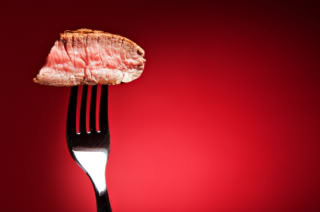 Early last week, I received an email from a reader. The subject was protein absorption, and it referred to something I’d written several weeks past in this post on Leptin Reset among other things. I had suggested that your body can only deal with about thirty grams of protein in one sitting. I immediately realized that this statement wasn’t nuanced enough and might give the wrong impression, so I explained what I meant in a bit more detail in the comment board. After receiving the following email (thanks for keeping me honest, Brandon!) I figured I would revisit this topic and further articulate what we know about the human body and dietary protein utilization.
Early last week, I received an email from a reader. The subject was protein absorption, and it referred to something I’d written several weeks past in this post on Leptin Reset among other things. I had suggested that your body can only deal with about thirty grams of protein in one sitting. I immediately realized that this statement wasn’t nuanced enough and might give the wrong impression, so I explained what I meant in a bit more detail in the comment board. After receiving the following email (thanks for keeping me honest, Brandon!) I figured I would revisit this topic and further articulate what we know about the human body and dietary protein utilization.
Let’s go.
Hi Mark,
I had a question about protein intake. In an older post, you mentioned something about anything beyond 30 grams of protein in a single meal likely being turned into glucose or fat, but I’ve heard different things from others. So, how much protein can you really use in one meal?
Brandon
First off, “meal” is the key word, one that I omitted in my original statement. Eating 50 grams of straight protein – and protein alone, whether it’s whey protein or 99% fat-free lean sirloin – is probably going to have a different effect than eating a mixed meal which contains 50-some odd grams of protein in addition to fat and digestible, fermentable, and insoluble carbohydrates. In other words, protein is rarely eaten alone. It’s eaten atop salads, alongside veggies, with starches, and it often comes imbued with animal fat (as meat). It’s eaten as a meal.
Digestion takes a long time, and it’s not a segmented procession of different meals through the gastrointestinal tract. Food isn’t separated into “meals” in your stomach. It’s just all food, all mashed together. If you still have breakfast in your stomach when your lunch enters the picture, lunch and breakfast will meet and mingle. Stomach acid breaks the food down into a big semifluid mass of partially digested food components, water, digestive enzymes, and hydrochloric acid – all referred to as chyme. When the chyme is “ready,” it’s pushed through the duodenum (where nutrient extraction begins) and into the intestines.
Once the protein part of the chyme has been broken down by enzymes into amino acids, amino acid absorption by the intestines can begin. Amino acid transporters grab amino acids and transport them through the cells lining the intestinal wall and from there into the bloodstream to be delivered to other parts of the body. But because the pool of amino acid transporters is limited, amino acids are typically absorbed by the small intestine at a rate of 5-10 grams per hour. This would suggest, at first glance, that the original “30 grams of protein per sitting” figure is close to correct. If you can only absorb, say, 7 grams of protein per hour, and the bolus of digested protein and other foods takes 4 to 5 hours to wind its way through the intestine, you’re gonna absorb maybe 28-35 grams. Right?
Not exactly. It turns out that our digestive process is fairly fine-tuned and regulated by the composition of whatever’s being digested. The presence of protein in chyme actually causes the secretion of CCK, a hormone that slows down the intestinal contractions that move food along, thus giving the protein more time to be transported by amino acid transporters. So, while it’s technically true that we aren’t absorbing 30 grams (let alone more) of protein all at once, it will eventually be absorbed.
Clearly, a fair amount is directed to normal tissue growth and repair. If it’s much more than that, a few possibilities enter the picture. Some will be directed towards a short term storage option referred to as the “labile protein reserve.” In this case, skeletal muscle tissue will take up some of the excess amino acids and simply store then for possible near future use (like within a day or so or for emergencies). Beyond that, your body will want to oxidize excess amino acids directly for fuel or convert them to glucose in the liver via gluconeogenesis. It will convert the nitrogen from the amino acids into ammonia and you will excrete that in your urine. If levels get too high in the bloodstream, your pH will shift (more acidic) and calcium will be called upon to balance pH out again. As we have seen with some people going full Primal, larger intakes of protein can offset lowered carb intake by generating significant rises in glucose through gluconeogenesis. Indeed, there are a lot of options the body has when you eat a high protein meal.
I still wouldn’t “stuff” myself on protein. If you have to force feed that lean chicken breast, perhaps your body’s trying to tell you something. Upon digestion, excess carbs and fat can be limitlessly and easily absorbed and assimilated (as body fat or glycogen) or burned off, but excess protein still requires extra work. Protein digestion produces toxic metabolites that we can usually get rid of, even on higher protein intakes, but there’s clearly a limit. Our bodies finding protein to be extremely filling? Our intestines actually slowing down the digestive process when protein is present? This is just how our bodies absorb protein at their own pace. They take their sweet time, but they get it all.
Okay, so we do absorb most of the protein we eat, whether it’s a 30-gram whey shake that’s absorbed in a couple hours or a large porterhouse whose protein is absorbed in ten hours. We’re not pooping amino acids. But are we using all that protein? Is it doing uniquely proteiny stuff, like building muscle? Or will everything above 30 grams get converted into glucose?
That depends. Many factors affect how your body utilizes a given amount of protein:
Body Size
If you’re a bigger person (longer limbs, more potential spots for amino acids to be utilized), you can handle more absolute protein, and that protein will be more likely to go toward muscle protein synthesis.
If you’re smaller, the reverse is true. You simply don’t need as much absolute protein for structural demands, and you’ll have a lower threshold before protein becomes an energy substrate. If you eat the same steak as the bigger guy (all else being equal), you won’t “use” as many of the amino acids as he will.
Activity Level
Are you sedentary? You require less protein. Your muscles aren’t getting the signal to build and grow stronger and adapt to an imposed demand. The RDA of 0.36g/lb bodyweight should suffice.
Are you moderately active, jogging here and there, maybe riding the bike to work once or twice a week, and doing some basic lifting in the gym? You can use a bit more, as physical activity increases protein demand.
Are you actively trying to pack on muscle mass, and working out accordingly? You can use a lot more protein, up to and perhaps even over 1g/lb bodyweight.
Age
Muscle maintenance in the elderly seems to require larger relative amounts of dietary protein. In one study, the RDA of 0.36g/lb bodyweight wasn’t enough to prevent some muscle catabolism.
Stress Level
Chronic stress, as indicated by chronically elevated cortisol levels, reduces muscle protein synthesis (protein doing proteiny stuff) and increases gluconeogenesis (conversion of protein into glucose).
It’s also worth noting that amino acids do other stuff, too, beyond building muscle and providing energy substrates when in excess. It’s not as if amino acids that don’t go toward rippling pecs are immediately converted into glucose. No, they’re also:
Taken up by the intestines, both as an energy source for the small intestine and to form a reserve pool of amino acids that the body can draw upon during fasting or starvation (when there’s little to no dietary amino acids input) instead of breaking down skeletal muscle to turn into energy.
Precursors for various neurotransmitters (like serotonin and dopamine).
So, to answer the question – yes, we’re probably absorbing all the protein we eat, but, depending on what we’re doing with our time, how old we are, how large or small we are, how active we are, how much we’re lifting, and how much stress we’re under, we’re all using the protein we absorb in different ways and proportions. As is often the case, the answer brings up even more questions. But that’s okay, because that’s just something else to explore.
Until next time, Grok on!
Grab The Primal Blueprint Cookbook Today and Receive Free S&H and a Free Primal Blueprint Poster

July 8, 2012
Weekend Link Love
 How a kind of bacteria carried by pet dogs can protect you from asthma. And no, this doesn’t mean you have to French kiss your pet to get the effect.
How a kind of bacteria carried by pet dogs can protect you from asthma. And no, this doesn’t mean you have to French kiss your pet to get the effect.
In a recent study, short, 8-second bursts of cycling sprints reduced belly fat in overweight men. They added muscle, too.
Why both diet and exercise are vitally important: calorie restriction for life extension doesn’t work very well without concomitant physical activity.
Glucose deprivation activates a feedback loop that kills cancer cells. Hmm, now how would one go about depriving one’s cancerous cells of glucose?
For all you fat-adapted readers out there: adding sprint intervals to low level cardio increased glycogen depletion without lowering fat oxidation or increasing hunger. Win-win-win!
If you’re gonna stretch before a workout, dynamic beats the pants off static. Here’s why.
A Facebook Group called Paleo Nursing Donors has been created by paleo-enthusiast Rachel Huizenga Jennings that is “dedicated to helping babies in need of grain, legume, and dairy free breastmilk find donors. There are many babies with special needs who can benefit from milk donations made by a Mom on a paleo diet!”
Strawberry season isn’t for much longer (at least in California). Here’s yet another reason to take advantage of it.
Recipe Corner
Who needs pasta when you can just make pork skin noodles?
Though the 4th has come and gone, you can still try Chris Kresser’s great recipe for colorful coleslaw.
Time Capsule
One year ago (July 8 – July 14)
Meal Timing Concerns: Breakfast, Frequency, and Snacking – Everything you ever wanted to know about the impact of when and how often you eat.
Dear Mark: Eating Meat – In which I address various questions from our readers concerning the eating of animal flesh.
Comment of the Week
Vegans and PB followers might both wear Vibrams but there are other distinguishing characteristics.if they look like the person working in the health food store, they are probably vegan. If they look tanned, buff, and vibrant they are most likely Primal.
- Well said, Dave.
Grab The Primal Blueprint Cookbook Today and Receive Free S&H and a Free Primal Blueprint Poster

July 7, 2012
Lime and Basil Beef Kebabs
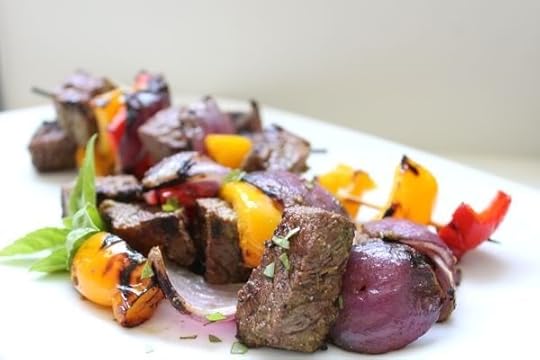 The marinade for Lime and Basil Beef Kebabs is so deliciously aromatic that it’s tempting to take a sip before you pour it over the beef. Fresh lime juice, orange zest and basil are blended together with garlic, cumin and coconut oil for a zesty flavor combination that intensifies over an open flame. The lime and cumin dominate in the end, with hints of the basil and orange sneaking in.
The marinade for Lime and Basil Beef Kebabs is so deliciously aromatic that it’s tempting to take a sip before you pour it over the beef. Fresh lime juice, orange zest and basil are blended together with garlic, cumin and coconut oil for a zesty flavor combination that intensifies over an open flame. The lime and cumin dominate in the end, with hints of the basil and orange sneaking in.
Add chunks of bell peppers and onion to the skewers and you’ll have a balanced meal cooking together on one stick. The beef will be charred on the outside and medium-rare in the middle, and the veggies will be seared by the heat but still crisp and fresh.
There are many cuts of beef that work well for kebabs, depending on how much you want to spend. Ask your butcher which cuts they recommend and also keep in mind that the marinade will help tenderize the meat if you buy a less-expensive cut. While this lime and basil marinade is perfect for beef, there’s no reason it wouldn’t be equally good over lamb or pork.
Servings: 3 to 4
Ingredients:
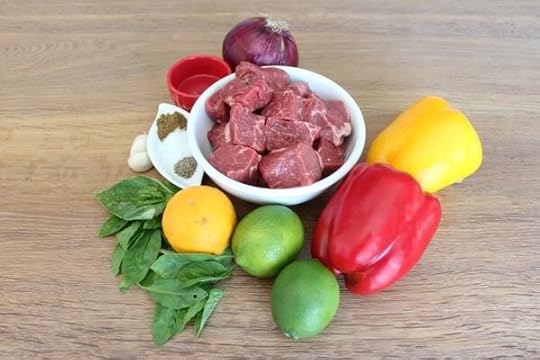
1 pound of beef (try chuck, top sirloin, rib-eye, tri-tip or tenderloin) cut into 1-inch cubes
1/4 cup fresh lime juice
2 tablespoons coconut oil
1 teaspoon grated orange peel (zest)
2 garlic cloves, peeled
1 handful of basil leaves
1 teaspoon ground cumin
1/2 teaspoon salt
1/4 teaspoon black pepper
2 bell peppers, cut into 1-inch pieces
1 onion, red or yellow, cut into 1-inch pieces
Instructions:
Place the cubes of meat in a large, sealable plastic bag or a glass bowl. Set aside.
In a blender, combine lime juice, coconut oil, orange zest, garlic cloves, basil, cumin, salt and pepper until smooth.
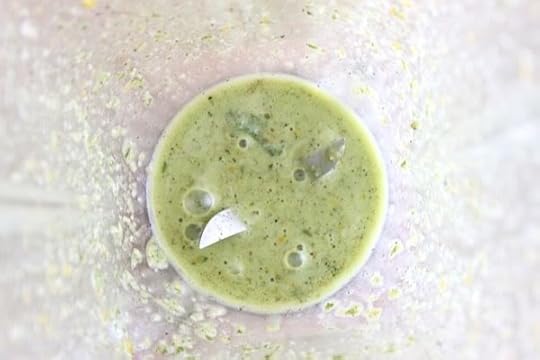
Pour over the meat. Let sit for 1/2 hour at room temperature or marinate for up to two hours in the refrigerator.
In a separate bowl toss the bell peppers and onion with either a little bit of the marinade or a drizzle of oil and a sprinkle of salt and pepper.

While the meat is marinating, heat the grill to high. If you’re using bamboo skewers, soak in water for 1/2 hour so they don’t burn on the grill – you’ll need about 6 skewers.
Skewer the meat and veggies, alternating chunks of meat with bell pepper and onion. Grill with the lid down for 8 minutes, turning the skewers every two minutes.

Grab a copy of Primal Blueprint Quick & Easy Meals for over 100 Primal Recipes You Can Prepare in 30 Minutes or Less

Mark Sisson's Blog
- Mark Sisson's profile
- 199 followers



